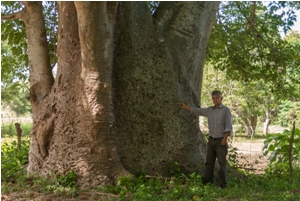Terrible, if we could consider its origen legend. They say that it was one of the most bgeautiful trees in Africa, for its foliage and its flowers, but it was too vain so that the gods berried its branches and only left to be seen its roots. Maybe in order to extend the punishement, it was doom to lilve 3 000 years.
According to the botanist Roberto Adán Pérez, teacher of the University of Camagüey, in 1916 were planted a caguairán, three guáimaros and a black zapote, which shape the patrimony of the current Politechnical Institute of Agronomy Álvaro Barba Machado.
Why are these rare species? The caguairán has a very valuable timber, hard, resistant and compact.
The guáimaro, names a municipality of Camagüey although there are few of these trees. Its fruit can be eaten and from its seeds is created a good flour for animals and humans.
There are not too many black zapotes in Cuba. Its fruit is an excellent laxative, although not use very often.
The Botanical Garden has hundreds of interesting species. In a few years we will be able to find many things like, a banana plant that only produce seeds or the unique corifa of the province, which takes 60 years to flower and suddenly die and that with its only two leaves it can cover a small house.
We have valuable plants of the worl like the baobad, that according to teacher Adán is the thickest of Camagüey. Although it makes us feel small it gives us vitamin C with its fruits, that if ground, can produce something like coffee.
Translated by BA in English Language, Manuel Barrera Téllez
{flike} {plusone} {ttweet}

